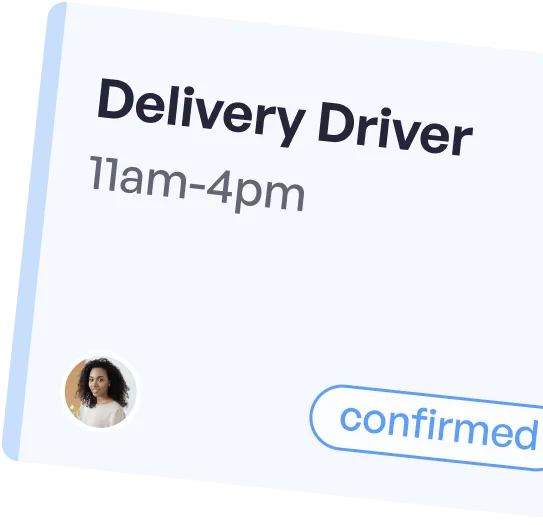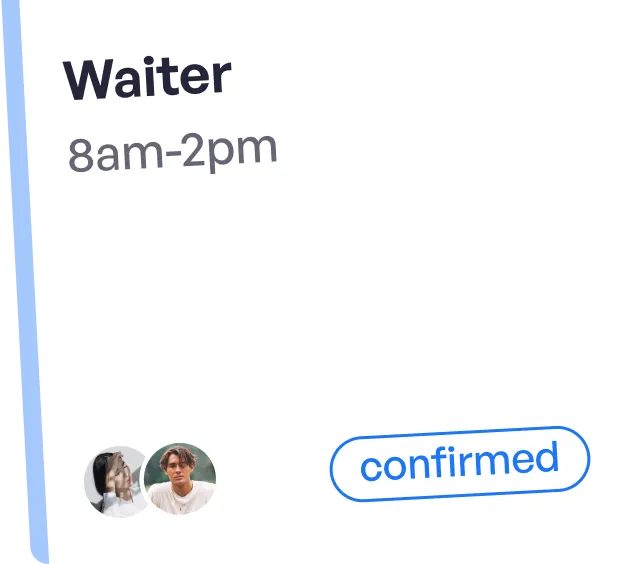Last Mile Delivery in Ireland: A Complete Guide for Restaurants & Hospitality

In this article, we'll explore everything you need to know about last-mile delivery, from the process of implementing it to the latest technologies that can transform your delivery operations in 2025.
What Is Last-Mile Delivery?
Last-mile delivery is the final stage of the delivery process, transporting goods from a local hub directly to the customer's doorstep. For Irish hospitality businesses, efficient last-mile delivery is crucial for customer satisfaction and operational success, ensuring orders arrive in perfect condition, delivered swiftly and professionally.
As John Ryan, CEO of Gigable, aptly puts it, "In the fast-paced world of Irish hospitality, reliable last-mile delivery isn't just a logistical detail; it's the cornerstone of customer satisfaction and business growth. It's about building trust, one timely delivery at a time."
Last-Mile Delivery: A Step-by-Step Breakdown
To truly understand the journey of a last-mile delivery, let's break it down into 5 key stages.
Step 1 – Receive Orders
The customer places their order through the restaurant's own website, a food delivery app, or even a good old-fashioned phone call. Once the order is confirmed, it pops up on the restaurant's system, ready for the kitchen to spring into action.
Step 2 – Prepare Meals or Packages
With the order in hand, the chefs get to work, ensuring every dish is cooked to perfection and packed securely to maintain its temperature and presentation during transit.
Step 3 – Assign Drivers
As the meal nears completion, the crucial step of assigning a driver takes place. This is where platforms like Gigable come into play. The restaurant, through the Gigable platform, can quickly and efficiently find an available and suitable driver from your favourite team or a pool of local, pre-vetted couriers.
Step 4 – Pick-Up & Real-Time Tracking Begins
Once assigned, the driver heads to the restaurant for pick-up. As they confirm the collection, the real-time tracking begins. The restaurant can monitor the delivery's progress, ensuring everything is running smoothly.
Step 5 – Deliver to Customer
Finally, the driver reaches the customer's doorstep, and the delicious meal is handed over. In many cases, especially for higher-value orders or for record-keeping, an optional proof of delivery might be obtained. This could be a quick photo of the delivered package, a scan of a QR code, or a digital signature on the driver's app.
This final step completes the last-mile journey, leaving a satisfied customer and a successful delivery record.

Why Last-Mile Delivery is the Toughest (and Priciest) Part of the Journey
While the last mile might seem like just a small part of the entire delivery chain, it’s often the most complex, and surprisingly, the most expensive.
The Ever-Rising Cost of Fuel and Labour in Ireland
One of the most immediate and impactful challenges is the fluctuating cost of fuel. Every time a delivery van or motorbike sets out, it’s burning fuel, and with prices constantly shifting, it’s a moving target for businesses trying to manage their expenses.
Coupled with this is the rising cost of labour. Ensuring fair wages for drivers, especially those working flexible hours, is essential, but it adds to the overall operational cost. These aren't just abstract numbers; they directly affect how much a business has to charge for delivery or how much profit they can make per order.
Customer Expectations: Fast, Reliable, and Always in the Know
Today’s customers are savvier and more demanding than ever before. They don’t just want their order; they want it fast, they want it reliably, and they want to know exactly where it is at all times.
This expectation for instant gratification and constant updates puts immense pressure on businesses. If a delivery is late or if there’s no way to track it, customer satisfaction can plummet, leading to negative reviews and lost business. This is particularly true in the food delivery sector, where a cold meal due to a delayed delivery can ruin the entire experience.
Rural vs. Urban Challenges
Ireland’s diverse landscape presents its own unique set of last-mile challenges. Delivering to a bustling city centre like Dublin or Cork comes with the headache of traffic congestion, parking restrictions, and navigating narrow streets. Every minute spent stuck in traffic or searching for a parking spot adds to the delivery time and cost.
On the other hand, delivering to rural areas, such as the scenic but sparsely populated regions of Galway, brings different obstacles. Longer distances between deliveries, less predictable road conditions, and sometimes even a lack of clear addresses can all contribute to delays and increased fuel consumption. It’s a constant balancing act for delivery companies to optimise routes for both urban sprawl and rural stretches.
Delivery Failures and Food Quality Degradation
Nothing is more frustrating for a business than a failed delivery. This could be due to an incorrect address, the customer not being home, or even a simple miscommunication.
For restaurants, the fear of food quality degrading during transit is a constant concern. A perfectly cooked meal can quickly become unappetising if it’s stuck in traffic for too long or not kept at the right temperature. This directly impacts the customer’s experience and, ultimately, the restaurant’s reputation.

Real Delivery Times for Last-Mile Operations in Ireland
For food delivery, particularly during peak hours in urban centres like Dublin or Cork, customers often expect their meals within 30-60 minutes. This tight window is driven by the perishable nature of food and the desire for a hot, fresh meal.
However, the key here is transparency. Customers want to know when their package will arrive, even if it’s not immediate. This is where time windows become crucial. Providing a 1-hour or 30-minute delivery window, rather than a vague ‘sometime today’, significantly enhances the customer experience.
5 Game-Changing Technologies Transforming Restaurant Delivery
The landscape of last-mile delivery is constantly evolving, driven by technological advancements that aim to make the process more efficient, cost-effective, and customer-friendly. For restaurants, embracing these innovations isn't just about keeping up; it's about staying competitive and delighting their customers.
Here are five key technologies that are reshaping how food gets from the kitchen to your table:
1. Route Optimisation Software for Irish Delivery Businesses
The days when drivers relied solely on their local knowledge or basic mapping apps are gone. Smart route optimisation software is a game-changer. These systems use complex algorithms to calculate the most efficient delivery routes, taking into account real-time traffic conditions, multiple delivery stops, time windows, and even driver availability. This means less time spent on the road, reduced fuel consumption, and faster deliveries.
2. Real-Time Driver Tracking
As mentioned, transparency is key in today's delivery world. Real-time driver tracking, often facilitated through dedicated driver apps like Gigable's, allows both businesses to monitor the exact location of a delivery in real-time.
For restaurants, this provides invaluable oversight, enabling them to anticipate arrival times, manage customer queries, and quickly address any potential delays.
For customers, the ability to see their order moving on a map, with an accurate estimated time of arrival, significantly enhances their experience, reducing anxiety and building trust. It's like having a personal window into their meal's journey.
3. Third-party delivery Platforms
The traditional model of in-house delivery fleets or exclusive contracts with large courier companies can be rigid and expensive, especially for smaller businesses or those with fluctuating demand.
Third-party delivery platforms offer a flexible and scalable alternative. These platforms connect businesses with a vast network of independent, pre-vetted local drivers.
This model allows restaurants to scale their delivery capacity up or down as needed, whether it's for a busy Friday night rush or a quieter weekday afternoon, without the overheads of permanent staff or restrictive contracts. It's about having the right number of drivers, exactly when you need them.
4. Electronic Proof of Delivery (ePOD) for Food Delivery
Ensuring that an order has been successfully delivered to the correct person is vital for accountability and dispute resolution.
Electronic Proof of Delivery (ePOD) systems have replaced traditional paper-based methods, offering a more efficient and reliable solution. This can involve drivers taking a photo of the delivered package at the doorstep, scanning a QR code, or having the customer sign off directly on the driver's app. ePOD provides instant confirmation of delivery, reduces errors, and offers a clear audit trail, giving both the business and the customer peace of mind.
5. Micro-Fulfillment & Virtual Kitchens for Urban Delivery
The rise of 'dark kitchens' and multi-brand virtual restaurants has led to innovative approaches in last-mile logistics. Micro-fulfilment centres or local hubs are smaller, strategically located facilities that act as mini-warehouses or dispatch points.
For multi-brand kitchens, this means they can prepare food in a central location and then quickly dispatch it from a nearby hub, significantly reducing delivery times and improving efficiency. This model allows for greater flexibility and responsiveness, particularly in dense urban areas, by bringing inventory closer to the customer.
Last-Mile Delivery Trends in Ireland for 2025
The world of last-mile delivery is a dynamic one, constantly adapting to new technologies, changing consumer behaviours, and a growing emphasis on sustainability.
As we move further into 2025, several key trends are shaping the future of how goods, especially food, reach our doorsteps.
Sustainable Delivery Method
Deliveries in Ireland are going green. From EVs to e-bikes, businesses are cutting emissions and costs, thanks to grants and better infrastructure. In cities, bikes beat traffic and boost speed. Some restaurants now run bike fleets to appeal to eco-conscious customers.
It’s more than transport: greener packaging, smart routes, even drones. Sustainability is no longer optional - it’s a competitive edge.
AI & Automation for Smarter Dispatching
AI is revolutionising last-mile delivery, making it predictive, not reactive. It forecasts demand, matches drivers smartly, and reroutes around delays in real time. With IoT (Internet of Things) integration, everything from kitchens to vehicles syncs up, reducing errors and boosting efficiency. For Irish restaurants, it’s a game-changer, helping them compete with bigger players.
Gig Economy Staffing for F&B Delivery Operations
The gig economy has reshaped restaurant delivery, offering flexible, on-demand staffing without the overhead of full-time drivers. Restaurants can scale up for busy nights and scale down when it’s quiet, only paying for completed deliveries.
Drivers also benefit from the flexibility, often working across multiple apps to maximise income. The key to making it work? Using platforms that vet, train, and monitor contractors to maintain service quality and brand standards.
Hyperlocal Delivery Partnerships Growing in Ireland
Growing numbers of Irish restaurants are tapping into hyperlocal delivery - partnering with nearby businesses and community groups to share drivers, cut costs, and offer more personalised service. These grassroots networks work especially well in smaller towns, where local knowledge and collaboration often outperform big platforms.
How Gigable CMS Helps You Run Compliant Delivery Operations
In the competitive world of last-mile delivery, having the right partner can make all the difference. Gigable understands the unique challenges faced by Irish restaurants and retailers, and our platform is designed to provide solutions that empower your business. With Gigable, you gain access to a flexible, pre-vetted pool of local delivery drivers, ready to support your operations.
Whether you're managing the frantic pace of weekend rushes or the steady flow of daily drops, our platform gives you unparalleled control, transparency, and real-time insights.
Seamlessly manage your delivery needs without the significant overhead of hiring in-house staff or being tied down by restrictive third-party logistics contracts. We believe in giving you the tools to succeed, allowing you to focus on what you do best: serving your customers.
Here’s a typical Last Mile Delivery operation with Gigable:
- Orders are Integrated: When customers place food orders through platforms like Flipdish, Deliverect, or UpCo, these orders can be sent directly to Gigable for delivery.
- Businesses Create Gigs: Businesses create delivery jobs (called "gigs") on the Gigable platform. They set the specific hours and duration for each gig, and can quickly post many at once using the Multiple Gig Posting feature.
- Drivers Apply for Gigs: Independent, self-employed drivers (Freelancers) can then apply for these available gigs. Businesses can review their profiles and see star ratings from other businesses, which helps indicate their past performance.
- Drivers are Selected: Businesses can either manually choose drivers based on their ratings and profiles, or they can use Gigable's automated tools to select the best candidates based on pre-set preferences to pick their favorite couriers.
- Tracking Begins at Check-in: When a selected driver starts their gig, they "check in" using the Gigable mobile app. This activates GPS tracking, allowing the business to see the courier's location in real-time and monitor their progress.
- Live Location & Order Monitoring: Businesses have a dashboard where they can see the live status of all their orders. This includes knowing when an order has been assigned, picked up, and delivered to the customer.
- Delivery Confirmation: Once a driver successfully delivers an order, they update its status to "delivered" in the app. This action also makes them available to receive new delivery assignments.
- Performance Review and Payment: After a gig is completed, businesses can review the driver's performance and even see their travel path (geo-journey). Businesses are then prompted to pay the courier for their services.

FAQs: Last-Mile Delivery for Restaurants in Ireland
Here are some frequently asked questions about last-mile delivery, providing quick answers to common queries:
What is last-mile delivery?
Last-mile delivery refers to the final stage of the delivery process, where a product or package is transported from a local distribution centre or hub directly to the end customer’s doorstep. It’s the very last leg of the journey.
How do restaurants manage their own delivery drivers in Ireland?
Restaurants can manage their own delivery drivers through direct employment, requiring them to handle payroll, insurance, vehicle maintenance, and scheduling. Alternatively, many restaurants use flexible platforms like Gigable to access pre-vetted independent drivers on demand, avoiding the overhead costs while maintaining control over their delivery operations.
How can Irish restaurants reduce delivery costs and improve margins?
Irish restaurants can reduce delivery costs by avoiding traditional delivery overheads like permanent staff salaries and vehicle maintenance. Platforms that charge zero commission fees and allow shift-based recruitment help you keep more profit per order.
Using on-demand driver networks eliminates the need for contracts and allows restaurants to scale delivery capacity based on actual demand, paying only for completed shifts rather than fixed costs.
Final Thoughts: Mastering the Last Mile with Smart Tech and Strategy
The last mile of delivery, while presenting its fair share of challenges, is also ripe with opportunities for businesses willing to embrace innovation and strategic partnerships. For restaurants and hospitality businesses in Ireland, understanding and optimising this crucial stage is no longer a luxury but a necessity for survival and growth.
Ultimately, mastering the last mile isn’t just about logistics; it’s about building stronger customer relationships, enhancing brand reputation, and ensuring the long-term success of your business in an increasingly demanding market. With the right tools and a forward-thinking approach, the final stretch can become your strongest asset.
Try Gigable today
Take the next step and join Gigable today. Let's put those insights into action and boost your business or freelance career!



More articles

Holiday Staffing Made Easy: Gigable’s Win-Win Approach to Compliance & Contractor Retention

Restaurant Employee Retention Strategies That Actually Work in 2025

